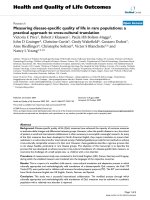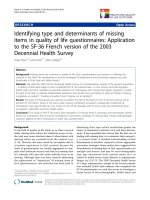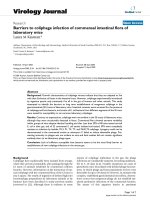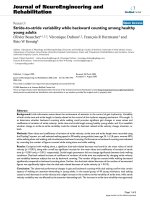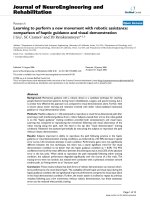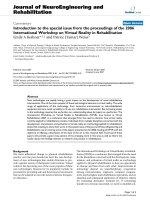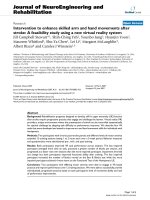báo cáo hóa học:" Barriers to coliphage infection of commensal intestinal flora of laboratory mice" pptx
Bạn đang xem bản rút gọn của tài liệu. Xem và tải ngay bản đầy đủ của tài liệu tại đây (249.54 KB, 7 trang )
BioMed Central
Page 1 of 7
(page number not for citation purposes)
Virology Journal
Open Access
Research
Barriers to coliphage infection of commensal intestinal flora of
laboratory mice
Laura M Kasman*
Address: Department of Microbiology and Immunology, Medical University of South Carolina, BSB-201, P.O. Box 250504, 173 Ashley Avenue,
Charleston, SC 29403, USA
Email: Laura M Kasman* -
* Corresponding author
Abstract
Background: Growth characteristics of coliphage viruses indicate that they are adapted to live
with their Eschericia coli hosts in the intestinal tract. However, coliphage experimentally introduced
by ingestion persist only transiently if at all in the gut of humans and other animals. This study
attempted to identify the barriers to long term establishment of exogenous coliphage in the
gastrointestinal (GI) tracts of laboratory mice. Intestinal contents were screened for the presence
of coliphage and host bacteria, and strains of E. coli bacteria from different segments of the GI tract
were tested for susceptibility to six common laboratory coliphages.
Results: Contrary to expectations, coliphage were not evident in the GI tracts of laboratory mice,
although they were occasionally detected in feces. Commensal flora showed extreme variability
within groups of mice despite identical handling and diet. Less than 20% of 48 mice tested carried
E. coli in their gut, and of 22 commensal E. coli strains isolated and tested, 59% were completely
resistant to infection by lambda, M13, P1, T4, T7, and PhiX174 coliphage. Lysogeny could not be
demonstrated in the commensal strains as mitomycin C failed to induce detectable phage. Pre-
existing immunity to phages was not evident as sera and fecal washes did not contain significant
antibody titers to six laboratory phage types.
Conclusion: Lack of sufficient susceptible host bacteria seems to be the most likely barrier to
establishment of new coliphage infections in the mouse gut.
Background
Coliphage have traditionally been isolated from sewage,
where they arrived, presumably, after passing through the
GI tracts of animals inhabited by commensal coliform
bacteria. However, information on the interaction of nat-
ural coliphage with the commensal flora of the GI tract in
situ is sparse. The results of ingestion of defined high titer
bacteriophage preparations by laboratory animals or by
humans have been described in many previous studies
(reviewed in [1]). Although there is evidence in some
reports of coliphage replication in the gut, the phage
infections are consistently transient, becoming undetecta-
ble in 3–10 days [2-4]. Notable exceptions are cases of
gnotobiotic mice inoculated with defined phage-host sys-
tems, in which phage and host populations in feces were
detectable for up to 98 days [4]. However, in animals with
complex, established gastrointestinal microflora, observa-
tions concur that exogenous phage do not establish sus-
tained productive infections of the commensal bacteria.
The nature of this apparent barrier to persistent
Published: 15 April 2005
Virology Journal 2005, 2:34 doi:10.1186/1743-422X-2-34
Received: 08 April 2005
Accepted: 15 April 2005
This article is available from: />© 2005 Kasman; licensee BioMed Central Ltd.
This is an Open Access article distributed under the terms of the Creative Commons Attribution License ( />),
which permits unrestricted use, distribution, and reproduction in any medium, provided the original work is properly cited.
Virology Journal 2005, 2:34 />Page 2 of 7
(page number not for citation purposes)
bacteriophage infection of the normal GI tract is of practi-
cal interest since as parasites of commensal bacteria, bac-
teriophage have the potential to impact health by altering
the GI flora. Conversely, it may be possible to engineer
phage specifically to alter the commensal flora in situ for
therapeutic benefit.
Previous work has already shown that potential physical
obstacles to bacteriophage infection of bacteria in the gut
are not significant. The acid environment of the stomach
would at first appear to be an obvious barrier, but col-
iphage have been shown to maintain their infectivity
when passed through the stomach or exposed to gastric
fluids [4-7]. Attachment of phage to the host bacteria
could be inhibited by secretions or deficiencies of cofac-
tors in the GI environment, however infection of bacteria
in the gut has also been demonstrated for a variety of
phage [5,8,9], including the temperate phage, CTXphi, of
Vibrio cholerae. CTXphi in fact infects its host more effi-
ciently in vivo than in vitro, because the phage has
adapted to use as its receptor V. cholerae surface molecules
expressed only when the bacteria colonizes the gut [10].
However, V. cholerae is not normal flora, and CTXphi lys-
ogens and phage are cleared in the usual time frame. In
addition, antimicrobial phage therapy trials have demon-
strated phage infection of bacteria in the peritoneal cavity,
blood, muscle [1,11] and embryonated hen eggs (L. Kas-
man, unpublished observations). Therefore, the in vivo
environment itself does not directly prevent infection of
bacteria by phage.
Phage are immunogenic, even when introduced into the
GI tract [5,9] and so anti-phage antibodies may play a role
in the barrier to new phage infections in commensal col-
iforms. Alternatively, susceptible host bacteria may not be
present at high enough densities to allow persistent infec-
tion by coliphage. When phage concentration are low,
very high densities of host cells can be required to enable
a detectable number of infections to occur[12]. Commen-
sal intestinal bacteria are a climax community in which an
estimated 400 different species of bacteria fill all niches
with regard to locations and energy sources, so that new-
comers find it difficult or impossible to become estab-
lished [13,14]. A new bacteriophage could in theory face
a similar obstacle, although not in terms of metabolic
needs, as most phage lysogens inhibit superinfection of
their host by similar phage types.
In this study, these potential barriers phage colonization
of commensal bacteria were assessed for E. coli, by testing
the gut contents and feces of several strains of laboratory
mice for the existence of free coliphage and E. coli capable
of supporting phage infection. In addition, six well char-
acterized coliphage types were used to test commensal E
coli bacteria for susceptibility to phage infection, and sera
and mucosal secretions were examined for evidence of
anti-coliphage antibodies.
Results
Screening for endogenous coliphage in the feces of
laboratory mice
Feces of two independent groups of 40 and 48 ICR mice,
were screened every three days for a total of four sam-
plings for the presence of naturally occurring (endog-
enous) coliphage. Fresh fecal pellets were collected for
each mouse individually, resuspended in LB, then centri-
fuged and the supernatants spotted onto indicator E. coli
in top agar within 6 h of collection. Feces of small groups
of C57BL/6 and nude mice were also collected such that
over 400 samples were screened on indicator E. coli strains
CN13 (F-) and ER2738 (F+) for somatic and male-specific
phages respectively. A total of three samples from two
mice were positive for phage on the somatic phage host
only. All other feces samples were negative, indicating that
even in the mice positive for phage, the phage could only
be detected transiently.
Screening for coliphage and lysogens in the murine
intestinal tract
In order to investigate coliphage prevalence in the GI tract
as well as feces, 48 ICR and 15 C57BL/6 mice were eutha-
nized after a final feces collection, and GI tracts removed
aseptically to individual sterile petri dishes. Each GI tract
was divided into four segments: (1) stomach and duode-
num, (2) 10 cm of small intestine midway between the
duodenum and cecum, (3) cecum, and (4) colon and rec-
tum. Intestinal contents were collected by flushing each
segment with 1 ml L-Broth containing CaCl
2
and MgSO
4
,
into a microfuge tube. Samples were gently vortexed, sub-
jected to low speed centrifugation to pellet large particu-
lates, and the supernatants retained for phage detection as
described below. Known amounts of T4 and M13 phage
were added to rinses of one mouse as a control, which
demonstrated that the collection procedure and centrifu-
gation did not remove or destroy phage (data not shown).
Due to the near absence of detectable phage in ICR mouse
feces initially collected, two strategies to enhance col-
iphage detection were applied to the supernatants from
the murine GI tracts and final feces collection from ICR,
C57BL/6 and nude mice. First, in order to amplify phage
which might be present at levels too low to detect, permis-
sive E. coli host strains ER2738 or CN-13 were added to
liquid cultures containing aliquots of gut or fecal superna-
tants. Second, mitomycin C was added since coliphage
lysogens, which are otherwise undetectable by plaque
assay, can usually be reactivated to the free state by treat-
ment of the bacteria with the chemical mitomycin C.
Combinations of permissive cells and mitomycin C pro-
duced five different culture conditions for the enrichment
Virology Journal 2005, 2:34 />Page 3 of 7
(page number not for citation purposes)
of phage recovery from feces and gut contents (Table 1).
Supernatants from overnight cultures under these condi-
tions were assayed for the presence of phage by spotting
on ER2738 and CN13 agar overlays. Table 1 summarizes
the results of several experiments. No male-specific bacte-
riophage were detected in gut contents or feces of any lab-
oratory mice from two suppliers and three animal strains
(nude mice were analyzed by feces only). Somatic bacteri-
ophage were detected in the feces but not the gut contents
of one ICR mouse after enrichment, regardless of mitomy-
cin C treatment. Mitomycin C failed to produce any more
detectable coliphage.
Prevalence of commensal E. coli in laboratory mice
Prevalence of commensal E. coli was studied in 48 six-
week old female ICR mice, shipped together and housed
in 12 groups of 4 mice for two weeks in the MUSC animal
facility, maintained on a diet of tap water and sterilized
pellets. Aliquots of fecal suspensions and intestinal seg-
ment rinses for all mice were plated on individual
MaConkey agar plates. Although large numbers of bacte-
ria grew from all of the samples except some duodenum
segments, less than half of the plates had colonies with
morphology and color consistent with E. coli. Sixty-four
individual colonies were chosen from 64 different plates
and typed using the BioMerieux api20E system. It was
found that only 20 of the 64 selected colonies were E. coli,
36 were Klebsiella teragina or Enterobacter aerogenes, 3 were
Klebsiella ornithinolytica, 1 was Klebsiella pneumoniae pneu-
moniae, 1 was Myroides chryseobacterium indologenes, and 3
could not be identified. The 20 E. coli isolates were from 8
mice, so that only 8 of 48, or 17%, of the mice were found
to carry E. coli. E. coli prevalence and diversity of commen-
sal flora was similar in subsequent smaller groups of mice
surveyed.
Susceptibility of commensal E. coli to laboratory-adapted
coliphage
In total, 31 commensal E. coli strains recovered from four
different gastrointestinal compartments and verified by
BioMerieux species identification were collected from
both ICR and C57BL/6 mice. These strains were tested for
susceptibility to six well-characterized laboratory adapted
coliphage (Lambda, M13, P1, øX174, T4, and T7) by spot-
ting of two dilutions of each phage onto an agar overlay
inoculated with the strain to be tested. Divalent cations
CaCl
2
and MgSO
4
were supplied in the overlay as they are
required for infection by P1. Susceptibility was observed
as confluent lysis or individual plaques in the bacterial
lawn after 18 h incubation. Isolates from different com-
partments of the same mouse that had identical phage
susceptibility profiles were considered to be the same
strain, reducing the number of unique isolates from 31 to
22. Less than 50% of these commensal strains were sus-
ceptible to any of the six coliphage (Table 2). None of the
22 strains were susceptible to M13mp18 or lambda
phage. P1 was the broadest host range phage, and was
able to lyse 8 of 22 strains (36%) although plaques were
considerably smaller in all cases compared to T4, T7 or
øX174. Similar resistance was found in a panel of 15
human clinical E. coli isolates tested for susceptibility in
the same manner (Table 2).
Screening of mouse serum and mucosal secretions for anti-
coliphage antibodies
Pre-existing immunity in the form of mucosal or serum
antibodies might account for the absence of coliphage in
the gut. Fecal washes from 22 mice positive for lactose fer-
menting commensals were screened for IgA antibodies
against M13, Lambda, P1, PhiX174, T4 or T7 phages by
ELISA. There was variability in IgA reactivity between
Table 1: Titers of bacteriophage after enrichment cultures from murine feces and contents of the GI tract
Enrichment method
12345
Mouse strain source No additions CN-13 (F-)
bacteria
CN-13 (F-)
bacteria With
mitomycin C
ER2738(F+)
bacteria
ER2738(F+)
bacteria With
mitomycin C
ICR feces -
2
7 × 10
5
PFU
3
6 × 10
5
PFU
3
C57BL/6feces
BALB/c nudefeces
ICR GI
1
C57BL/6 GI
1
1
All four compartments were tested separately
2
– represents none detected. Minimum detectable titer was 10
2
/ml before enrichment.
3
Average of two mice, out of 88 tested. All others were negative.
Virology Journal 2005, 2:34 />Page 4 of 7
(page number not for citation purposes)
mice, but each individual mouse had similar reactivity to
all 6 phages (Figure 1A). Based on a cut-off of two stand-
ard deviations from the mean IgA response for any given
mouse, there was no evidence of phage specific mucosal
IgA antibodies in this group of animals. Sera from 9 mice
verified to be carriers of E. coli were likewise assayed for
the presence of IgG and IgM antibodies. No evidence of
phage-specific serum antibodies were found in any of the
mice (Fig 1B)
Discussion
Bacteriophages are assumed to be a normal component of
mammalian gastrointestinal microbial flora since they are
commonly isolated from feces and raw sewage and grow
most efficiently at temperatures approximating mamma-
lian body temperature. This study focused on the bacteri-
ophages of E. coli, since it is the commensal bacterial
species for which the most characterized phages are
known and it is easily grown in vitro. We also primarily
used outbred mice (strain ICR) to more closely approxi-
mate a human population, although diet and environ-
ment were kept homogeneous. Contrary to expectations,
with the exception of transient somatic phage infections
in the feces of 2 of 88 mice, coliphage were not evident in
the GI tracts of laboratory mice examined in this study.
Our detection limit was 100 PFU/ml for GI tract rinses
and approximately 100 PFU/gram feces before enrich-
ment. However, in theory, a single infectious phage parti-
cle or single lysogenic cell should be detectable after
enrichment. Coliphage densities in feces of domestic ani-
mals have been reported to vary widely by species [15].
Our results suggest that laboratory mice have some of the
lowest fecal phage densities tested for domestic animals,
but comparable to that reported for humans [15]. This
was true for mice from two suppliers, and could have been
a result of intentional association of the laboratory ani-
mals with a defined flora at the breeding facility. How-
ever, a defined flora also was not evident in these animals.
At least with regard to aerobes, the commensal flora of the
mice was very diverse despite the fact that the animals
were all maintained in a barrier facility and fed the identi-
cal sterilized chow and water. E. coli, in particular, were
detected in less than 20% of the animals, and 54% of ani-
mals produced no lactose fermenters at all on MaConkey
agar.
The finding that murine commensal E. coli strains isolated
were mostly resistant to infection by lambda, M13, P1, T4,
T7, and PhiX174 coliphage was at first suggestive of a cli-
max community of phage. However, superinfection exclu-
sion became an unlikely mechanism for this resistance
given the lack of phage production in response to mito-
mycin C. In addition, no phage-specific antibodies to
known coliphage types were found in the sera or fecal
washes of mice known to be colonized with E. coli. Phage
are well known to be highly immunogenic in mice when
injected and to pass into the blood when ingested in large
numbers [7]. Taken together, these results indicate that
the inability to establish persistent coliphage infections in
commensal flora was not due to a climax community of
phage already existing in the mouse.
Given the small percentage of commensal E. coli strains
found to be susceptible to known coliphage types, the
main barrier to establishment of new coliphage infections
in the gut was most likely insufficient host cell density. It
is estimated that in human E. coli carriers, 1 in 10,000 bac-
terial cells in the gut is an E. coli cell, and one gram of nor-
mal human feces contains roughly 10
6
live E. coli. If ideal
conditions were present, such that there were 10
6
suscep-
tible cells per ml of gut content, and the gut is assumed to
approximate a liquid environment, then it can be calcu-
lated that a given phage present at a concentration of only
10 PFU/ml would be expected to infect on average two E.
coli cells per ml of gut per hour[12]. However, conversely,
in order to infect every available E. coli cell in such ideal
conditions would require a phage concentration exceed-
ing 1.5 × 10
6
PFU/ml. Based on our experience, the mouse
intestinal volume is less than 3 mls, and the susceptible E.
coli population is much lower. In addition, the majority of
intestinal bacteria are located in the cecum and colon,
where they will be eliminated from the body the most rap-
idly. It should be noted that the majority of microorgan-
isms in the mammalian gut are anaerobes. Very little is
known about bacteriophage of these organisms, but is
possible that bacteriophages of anaerobes or bacteria
other than E. coli would produce a different outcome.
Conclusion
The purpose of this investigation was to identify the barri-
ers to long term establishment of coliphage in the GI tracts
of laboratory mice. It was found that (1) laboratory
Table 2: Susceptibility of commensal E. coli strains to lysis by laboratory coliphage (percent susceptible strains)
Source of E. coli Lambda M13 P1 øX174 T4 T7 none
Mouse feces and GI tracts (n = 22) 0 (0%) 0 (0%) 8 (36%) 3 (14%) 4 (18%) 3 (14%) 13 (59%)
Human clinical specimens (n=15) 1 (7%) 1 (7%) 6 (40%) 1 (7%) 1 (7%) 2 (13%) 7 (47%)
Virology Journal 2005, 2:34 />Page 5 of 7
(page number not for citation purposes)
Absence of specific antibodies to commensal coliphage by ELISAFigure 1
Absence of specific antibodies to commensal coliphage by ELISA. (A) Fecal washes from 22 ICR mice found to be
colonized with lactose fermenting commensal bacteria were assayed in duplicate for IgA antibodies against M13mp18, Lambda,
P1, øX174, T4 and T7 coliphages in parallel ELISA plates. Mice 2B, 2R, 2G, 2N, 3G, 3R, 4N, and 6G were eventually shown to
carry E. coli. Each symbol represents the mean absorbance reading for one phage type. (B) Sera from 9 mice verified as E. coli
carriers were assayed in duplicate for IgG and IgM antibodies against the same six coliphage by ELISA. Each symbol represents
the mean absorbance reading for one phage type.
Virology Journal 2005, 2:34 />Page 6 of 7
(page number not for citation purposes)
animals living under identical conditions and with an
identical diet can have very different populations of com-
mensal intestinal bacteria, (2) E. coli, while common in
human intestinal tracts were relatively rare in the guts of
laboratory mice, (3) commensal E. coli found in the GI
tract of normal laboratory mice were resistant to several
types of coliphage. In conclusion, lack of sufficient sus-
ceptible host bacteria seems to be the most likely barrier
to establishment of new coliphage infections in the mam-
malian gut. The results suggest that altering commensal E.
coli with coliphage in situ will be very difficult due to the
high variability of commensal flora between individuals,
and the low probability of a coliphage particle making
contact with a susceptible cell in the gut.
Methods
Bacterial strains and coliphage
Male specific phage host strain E. coli ER2738 (F'proA
+
B
+
lacI
q
delta(lacZ)M15zzf::Tn10(Tet
R
) and M13mp18 col-
iphage were obtained from New England Biolabs (Beverly
MA). Somatic phage host E. coli strain CN13, and col-
iphages T4 and T7 were purchased from the American
Type Culture Collection, Rockland MD. Coliphage P1 and
PhiX174 were from generously provided by Dr. Caroline
Westwater (Medical University of South Carolina).
Lambda gt11 (Promega, Madison, WI). was generously
provided by Phillip Werner, Medical University of South
Carolina. E. coli bacterial strains grown from de-identified
human clinical specimens were provided by Dr. Lisa
Steed, Dept. of Pathology and Laboratory Medicine,
MUSC. Bacteria were grown in Luria Broth with or with-
out agar (Difco) or on Maconkey agar (Difco) as noted.
Mitomycin C was purchased from Sigma and used at a
concentration of 2 µg/ml.
Mice
Female ICR and C57BL/6 mice were obtained from Har-
lan Laboratories, C57BL/6 mice were also obtained from
Jackson Laboratories. Feces from nude mice were pro-
vided by Dr. Mark Hyer (Medical University of South
Carolina). All mice were housed and cared for in the
MUSC animal facility and handled according to protocols
approved by the MUSC Institutional Animal Care and Use
Committee.
Survey for lysogeny and isolation of E. Coli strains
Gastrointestinal tracts from adult ICR and C57/BL6 mice
were collected from fresh cadavers and divided into four
segments: (1) stomach and duodenum, (2) 10 cm of
small intestine midway between the duodenum and
cecum, (3) cecum, and (4) colon and rectum. Intestinal
contents were collected by flushing each segment with 1
ml L-Broth containing 5 mM CaCl
2
and 10 mM MgSO
4
,
vortexed briefly, and centrifuged at 50 RCF to remove
large particulates. Aliquots of supernatant were plated
onto MaConkey agar to isolate commensal E. coli.
Remaining supernatant was divided and incubated under
5 different conditions to enrich for coliphage: (1) No
added host bacteria, no mitomycin C, (2) CN-13 host bac-
teria and 2 µg mitomycin C/ml, (3) CN-13 host bacteria
and no mitomycin C, (4) ER2738 host bacteria and 2 µg
mitomycin C/ml, (5) ER2738 host bacteria and no mito-
mycin C. After 18 h shaking at 37°C, enriched cultures
were pelleted by centrifugation at 20,800 RCF. The pres-
ence of male-specific phage and somatic phage in the
supernatant was assayed by spotting 10 µl onto host cells
according to Method 1601 of the United States Environ-
mental Protection Agency for detection of coliphage in
fresh water samples[16], except that New England Biolabs
strain ER2738 was substituted for strain F
amp
E. coli. Fecal
washes were prepared by resuspending fecal pellets in PBS
containing 0.2% sodium azide at a ratio of 100 mg feces
per ml. Particulates were pelleted at 14 krpm in a micro-
fuge and the supernatants frozen until analysis.
Spotting Assay for presence of phage and analysis of phage
susceptibility
The EPA protocol for detection of coliphage in drinking
water[16] was followed except that E. coli strain ER2738
was substituted for strain F
amp
. Fecal pellets were resus-
pended as a 10% slurry (weight to volume) in LB contain-
ing 10 mM CaCl
2
and MgSO
4
. For detection of phage in
feces, slurries were centrifuged 10 minutes at 14 Krpm in
a microcentrifuge to remove particulates before spotting
10 µl onto E. coli inoculated top agar overlay. For determi-
nation of phage susceptibility, verified commensal E. coli
strains or ER2738 and CN13 control strains were grown to
logarithmic phase in LB and 0.1 ml of culture used to
inoculate 3 mls molten LB top agar (0.6% agar, 42°C)
which was poured onto an LB agar base. When top agars
were dry, 10 µl intestinal wash or 5 µl of two dilutions of
lab adapted phage (Lambda, M13mp18, P1, PhiX174, T4,
and T7) were spotted onto the top agar. For phage suscep-
tibility testing, the highest dilution producing complete
clearing on the control strain, and the dilution ten-fold
more concentrated were used. Plates were read after incu-
bation 18–20 h at 37°C.
Bacterial species verification
For isolation and verification of commensal E. coli strains,
single bacterial colonies with suspected E. coli morphol-
ogy were picked from MaConkey agar plates inoculated
with gut contents or feces. Each colony was restreaked on
a separate MaConkey agar plates and single colonies ana-
lyzed with the BioMerieux api20e typing kit for species
identification according to manufacturer's instructions
(BioMerieux, Inc. Durham, NC).
Publish with BioMed Central and every
scientist can read your work free of charge
"BioMed Central will be the most significant development for
disseminating the results of biomedical research in our lifetime."
Sir Paul Nurse, Cancer Research UK
Your research papers will be:
available free of charge to the entire biomedical community
peer reviewed and published immediately upon acceptance
cited in PubMed and archived on PubMed Central
yours — you keep the copyright
Submit your manuscript here:
/>BioMedcentral
Virology Journal 2005, 2:34 />Page 7 of 7
(page number not for citation purposes)
ELISA
ELISAs were performed in Reacti-Bind™ maleic anhydride
activated clear 96-well plates (Pierce, Rockford IL) coated
overnight with one of 6 phages (M13mp18, Lambda, P1,
øX174, T4 or T7) in sterile filtered bacterial culture
supernatants diluted in PBS. Fecal washes were tested for
the presence of phage-specific IgA antibodies, at a dilution
of 1:3 in duplicate wells for 2 h at room temperature,
using a goat anti-mouse IgA-alkaline phosphatase conju-
gated secondary antibody (Southern Biotechnology
Assoc., Birmingham AL) and Super Signal chemilumines-
cent substrate (Pierce). Mouse sera were incubated in the
same manner except at a 1:6 dilution and utilizing sec-
ondary HRP-conjugated antibodies recognizing mouse
IgG or IgM (Sigma) to detect phage-specific antibodies.
Sera from mice immunized with the laboratory phages by
intraperitoneal injection served as positive controls.
Horseradish peroxidase conjugated secondary antibodies
were detected by incubation with 1-Step ABTS (Pierce).
Competing interests
The author received salary and support from September
1999 to May 2001 under a research contract, which ended
in 2001, between Hexal AG, (Industriestraβe 25, 83607
Holzkirchen, Germany) and the Medical University of
South Carolina to develop bacteriophage-based antimi-
crobial therapeutics. No products or patents based on this
work or any bacteriophage therapeutic are being pursued
by either Hexal AG or the Medical University of South
Carolina. The author declares no non-financial competing
interests.
Authors' contributions
LK conceived of and designed the study, carried out the
experiments, analyzed the data and prepared the
manuscript.
Acknowledgements
This work was supported by a grant from the Medical University of South
Carolina University Research Council to LK. Laboratory space and access
to equipment were generously provided by James S. Norris, and the MUSC
Department of Microbiology and Immunology. Phillip A Werner provided
helpful assistance with bacteria typing assays.
References
1. Sulakvelidze A, Alavidze Z, Morris JGJ: Bacteriophage therapy.
Antimicrob Agents Chemother 2001, 45:649-659.
2. Weber-Darbrowska B, Dabrowski S: Studies on bacteriophage
penetration in patients subjected to phage therapy. Arch
Immunol Ther Exper 1987, 35:563-568.
3. Berchieri AJ, Lovell MA, Barrow PA: The activity in the chicken
alimentary tract of bacteriophages lytic for Salmonella
typhimurium. Res Microbiol 1991, 142:541-549.
4. Boyd JSK, Portnoy B: Bacteriophage therapy in bacillary
dysentery. Trans R Soc Trop Med Hyg 1944, 37:243-262.
5. Delmastro P, Meola A, Monaci P, Cortese R, Galfre G: Immuno-
genicity of filamentous phage displaying peptide mimotopes
after oral administration. Vaccine 1997, 15:1276-1285.
6. Smith HW, Huggins MB, Shaw KM: The control of experimental
Escherichia coli diarrhoea in calves by means of
bacteriophages. J Gen Microbiol 1987, 133:1111-1126.
7. Bogovazova GG, Voroshilova NN, Bondarenko VM: [The efficacy
of Klebsiella pneumoniae bacteriophage in the therapy of
experimental Klebsiella infection]. Zh Mikrobiol Epidemiol
Immunobiol 1991:5-8.
8. Ando A, Furuse K, Watanabe I: Propagation of ribonucleic acid
coliphages in gnotobiotic mice. Appl Environ Microbiol 1979,
37:1157-1165.
9. Zuercher AW, S. M. Miescher, M. Vogel, M. P. Rudolf, M. B. Stadler,
Stadler. BM: Oral anti-IgE immunization with epitopr display-
ing phage. Eur J Immunol 2000, 30:128-135.
10. Waldor MK, Mekalanos JJ: Lysogenic conversion by a filamen-
tous phage encoding cholera toxin. Science 1996,
272:1910-1914.
11. Westwater C, Kasman LM, Schofield DA, Werner PA, Dolan JW,
Schmidt MG, Norris JS: Use of genetically engineered phage to
deliver antimicrobial agents to bacteria: an alternative ther-
apy for treatment of bacterial infections. Antimicrob Agents
Chemother 2003, 47:1301-1307.
12. Kasman LM, Kasman A, Westwater C, Dolan J, Schmidt MG, Norris
JS: Overcoming the phage replication threshold: a mathe-
matical model with implications for phage therapy. J Virol
2002, 76:5557-5564.
13. Savage DC: Microbial ecology of the gastrointestinal tract.
Annu Rev Microbiol 1977, 31:107-133.
14. Smith HW: Survival of orally administered E. coli K12 in ali-
mentary tract of man. Nature 1975, 255:500-502.
15. Leclerc H, Edberg S, Pierzo V, Delattre JM: Bacteriophages as indi-
cators of enteric viruses and public health risk in
groundwaters. J Appl Microbiol 2000, 88:5-21.
16. EPA Document 821-R-00-009 (April 2000 Draft) Method
1601: Male Specific (F+) and Somatic Coliphage in Water by
Two-step Enrichment Procedure. 2000.

